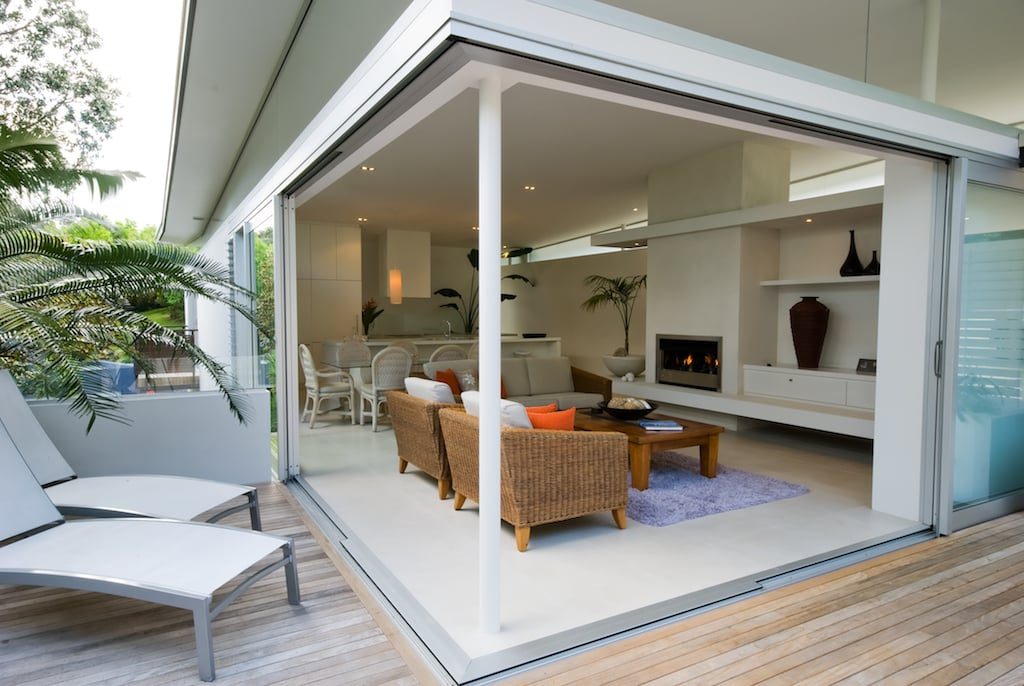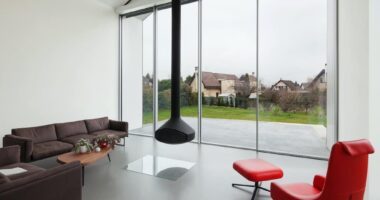Sliding patio doors are available in many different brands, systems, types and styles. With renewed interest in sliding doors, we take a look at some of the different types of sliding doors available. We also provide guidance and information on what the different styles mean. We explain terminology and other information about the different types of sliding doors. Finally there is information about the highly desirable open corner sliding doors.
Is your perception of sliding doors that they are white or silver, with wooden handles and a wooden subframe? Not so any more. The different types of sliding doors you can buy today are vastly different in virtually every way possible.
Previous generations of sliding patio doors were largely limited by their sliding action, their size limitations and suitability. Old patio sliding doors were ideal for new build properties or flats. These had a simple two-pane design with one fixed and one sliding leaf, either as a direct fix or within a hardwood subframe. Normally you got only two, three or four-panel doors, with a single track and heights rarely exceeding 2.4 metres.
Features of modern aluminium patio sliding doors.
There are several different types of sliding doors you can now buy. Every one of these provides a perfect patio door to suit any type of property and customer requirement. A modern aluminium sliding patio door will give you many great features. And many of these door types come tested to the latest security and performance standards.
- Bigger sliding door sizes at more than 9 square metres with most products.
- Flexible opening with half or two-thirds clear opening or more, depending on the design of the product.
- Slimmer door profiles thanks to the latest generation of thin sliding doors.
- A very contemporary appearance
- Exceptional design, quality, security and weather resistance.
- An extensive choice of colours.
Understanding the different types of sliding doors available.
Two areas will quite likely determine the sliding door that will be suitable for your home. The first is sliding doors to replace existing doors; the second is a sliding door into new extensions or renovations.
When replacing old doors with sliding doors, the size of the opening will primarily govern the type of sliding door you can have. With most openings, inline or lift and slide doors are possible as well as the new generation of slimline sliding doors.
New structural openings give far more flexibility. This then enables you to look at the different types of sliding doors and how they can work in your home.

Inline Sliding Doors.
The inline sliding door works on the conventional method of the door panel sliding within its frame. Modern inline sliding doors are excellent products. For example, the Dutemann Glide-S can go to more than 6 metres with just two panels. The new Alumen Cor-Slide Plus can go to 8 metres with just a 25mm mullion in the middle. Such is the engineering behind inline sliding doors.
Additionally, inline sliding doors are available in two, three and four panel designs in various sizes. You can also have inline doors with single, double or triple tracks. Multiple tracks allow panels to slide to the left or right. For those looking for multi-panel doors, Reynaers doors are one example available with multiple tracks that stack together to create up to 8 sliding door panels, all on separate tracks.
Lift and Slide Doors.
Lift and Slide doors operate just like the description suggests. Inline sliding doors slide by pulling on the handle. On Lift and Slide doors, it is the handle that controls a complex set of gearing around the door sash.
A turn of the handle operates the lift and slide gearing. The handle moves the door away from the frame, ready to slide to the desired position. Lift and slide doors are great, available in two up to six panels. The lift and slide door is very popular among all the different types of sliding doors.
Tilt and Slide Doors
Tilt and slide patio doors work on the principle of a sliding door and a tilt and turn window combined. When ventilation only is required, the tilt facility of the door enables the panel to lean back opening the top portion and the sliding door panel hinged along the bottom. The tilt and slide facility is controlled from the patio door handle. Comar sliding doors, Schuco as well as other well-designed systems are available as a tilt and slide option.
Slimline sliding patio doors.
There are now different types of sliding doors designed to provide a minimalist appearance. You also benefit from a big glass area and the least amount of visible aluminium. Many unique features of slimline sliding doors set them apart from conventional sliding doors.
Slimline sliding doors are available in sizes covering standard domestic openings right up to impressive 27m2, for example the Panoramah! system.
Pocket aluminium sliding doors.
If you are thinking of building a new extension, why not consider sliding doors that slide into the wall pocket, disappearing from view.
Pocket sliding doors should be designed from the outset as part of the new extension and building work, but they can create a dramatic door opening in the modern home. The big advantage of pocket aluminium sliding doors is their ability to open up the opening better than a bifolding door can.
Open Corner sliding doors.

Just like bifolding door systems, sliding doors can now be designed to meet in the corner on two elevations. Slide the doors back to reveal an open corner arrangement with no visible corner post (although you can choose a static corner post as well). You can even design open corner sliding doors to slide into a wall as a pocket aluminium sliding door system. If you want altogether different types of sliding doors for your new build project, these are outstanding.
To have open corner sliding doors in your home there are a number of important considerations.
- You will almost certainly need to employ a structural engineer. As there is no corner, a counterbalanced steel structure is therefore required. Not only is this to ensure structural strength in the roof but also to support the sliding doors. Remember no window or door is a self-supporting structure.
- Consider talking to an architect. While many good builders have the expertise necessary to fit open corner sliding doors, the services of an architect are invaluable with certain projects. As well as giving you a great design and helping with planning, Architects also do great work in other areas. For example, obtaining the door sliding into a wall pocket, an ultra-low threshold with weather resistance, not to mention preparing proper drawings.
- Ultra-slim doors are perfect as open corner sliding doors. However, these doors come with specific features and installation requirements you must be aware of.
- We strongly recommend your architect, builder and door installer work closely together at every stage of the process. Mistakes due to incorrect apertures, wrong size doors, incorrect floor levels etc are costly mistakes. Therefore ensure all parties communicate at all times and each understands the role of the other.
Automatic sliding patio doors.
Reynaers, Schuco, Luxal Glazing, Panoramah! and other systems offer automatic sliding doors opening and closing at the touch of a button.
The fitting of automatic sliding doors will require a specialist installer as well as the installation and commissioning of the powered operator.
Who makes the different types of aluminium sliding doors?
There is an enormous amount of choice in sliding door. However, it need not be complicated to find the right product. Our sliding door section illustrates just some of the many sliding door providers on the market. We can simplify the huge amount of choice by offering a few tips and insight into the sliding door market.
- It is the aluminium systems companies that mostly offer their own brands of sliding doors. Others take these names and sell them either under the same name or rebrand them to suit their business.
- There are no substandard or bad sliding doors on the market. Where they differ is in engineering, capability, aesthetics, warranties and quality of hardware.
- It is poor installation and manufacturing that is primarily responsible for problems, rarely is it the design of the product.
- Ask to see the security and weather performance testing of the product. A good installer will provide this information.
- Sliding doors will require a more complicated installation owing to their large size and glass panels. Here’s what you should know about how sliding doors are fitted.
Sliding doors articles
- the flush door Threshold. Accessibility, Safety, Style July 27, 2024
- The homeowners guide to Reynaers sliding doors July 2, 2023
- Schüco barrier free – creating accessible and stylish homes May 15, 2023
- how to get more natural light in a house March 27, 2023
- Supply only vs supply and fit, which is better? March 22, 2023
















